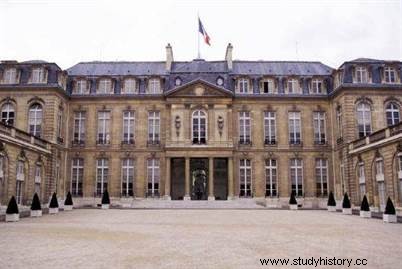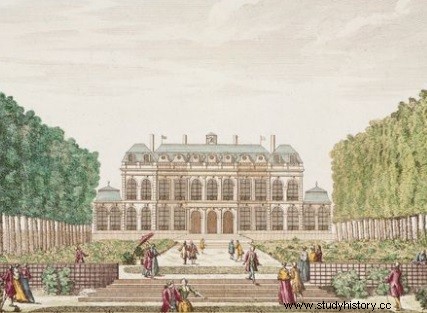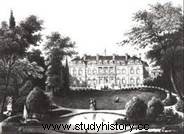 The Élysée Palace is an 18th century private mansion located at the bottom of the avenue des Champs-Élysées, in Paris, which became the residence of the presidents of the French Republic in 1873. Several times transformed, enlarged and embellished over the centuries, the palace of the 'Élysée has however retained its original main building. Each owner has added embellishments:woodwork, fireplaces, chandeliers, paintings, etc. The installation of the Presidency of the Republic in the palace led to additional modifications, such as the layout of the village hall under Sadi Carnot, the decorations of Lanel and Leleu under Vincent Auriol, the embellishments of Paulin and Agam under Georges Pompidou and finally the layout of the apartments by Wilmotte and the purchase of paintings by Garouste under François Mitterrand...
The Élysée Palace is an 18th century private mansion located at the bottom of the avenue des Champs-Élysées, in Paris, which became the residence of the presidents of the French Republic in 1873. Several times transformed, enlarged and embellished over the centuries, the palace of the 'Élysée has however retained its original main building. Each owner has added embellishments:woodwork, fireplaces, chandeliers, paintings, etc. The installation of the Presidency of the Republic in the palace led to additional modifications, such as the layout of the village hall under Sadi Carnot, the decorations of Lanel and Leleu under Vincent Auriol, the embellishments of Paulin and Agam under Georges Pompidou and finally the layout of the apartments by Wilmotte and the purchase of paintings by Garouste under François Mitterrand...
The Elysée Palace, a residence steeped in history
In the middle of a market garden plain, our current Faubourg Saint Honoré, the nephew by marriage of André Le Nôtre sold in 1718 the land he owned to Henri-Louis de the Tower of Auvergne, Count of Evreux. He had a mansion built there in four years. This construction marked the development of the district, one of the most beautiful in Paris. It was a classic construction with an entrance vestibule located in the axis of the Cour d'Honneur and the Gardens, a central body with a Grand Apartment called Parade Apartment in the middle of which is the Grand Salon overlooking the garden and two wings with the Baths Apartment on the right and the private apartments on the left. The entire exterior was framed by walls topped with balustrades.
 Thirty years later, the Marquise de Pompadour, wanting to have a "Parisian pied-à-terre", bought this hotel, carry out some work on the Parade Apartment, on the first floor as well as the garden where she introduces arbors, waterfalls, before settling there until 1764, then bequeathing it to Louis XV. Le Bien Aimé intended it for extraordinary ambassadors as a place of residence, then turned it into a sort of art gallery in 1765. Temporarily serving as the Crown Furniture Guard, it was sold in 1773 to the financier Nicolas Beaujon who transformed it profoundly by extending the Small Apartments, by modifying the Central Pavilion, the Parade Chamber transformed into a hemicycle, by dividing the Assembly Hall, by redeveloping the English garden with terraces, winding paths and the creation of a small lake.
Thirty years later, the Marquise de Pompadour, wanting to have a "Parisian pied-à-terre", bought this hotel, carry out some work on the Parade Apartment, on the first floor as well as the garden where she introduces arbors, waterfalls, before settling there until 1764, then bequeathing it to Louis XV. Le Bien Aimé intended it for extraordinary ambassadors as a place of residence, then turned it into a sort of art gallery in 1765. Temporarily serving as the Crown Furniture Guard, it was sold in 1773 to the financier Nicolas Beaujon who transformed it profoundly by extending the Small Apartments, by modifying the Central Pavilion, the Parade Chamber transformed into a hemicycle, by dividing the Assembly Hall, by redeveloping the English garden with terraces, winding paths and the creation of a small lake.
Louis XVI sold it to the Duchess of Bourbon, his cousin, who gave it the name Hôtel de Bourbon from 1787. His room was in the current Napoléon III library. . After the arrest of the Duchess in 1793, this private mansion saw several uses:in 1794 it served as the printing press for the Bulletin des Lois, then it was the furniture storage from the seizures of convicts or emigrants; after the release of the Duchess of Bourbon, she returned to her hotel in 1797 and rented the ground floor to the Hovyn family where popular balls were organized in 1797 (in order to have some income). They carried out work to open two arcades to let the public pass through the gardens and gave the hotel the name of Elysée.
The palace was sold by the Duchess of Bourbon, the rented apartments saw the presence of the Count and Countess Léon de Vigny and their son Alfred… To deal with the debts, the Hovyn family sold the hotel in 1805.
The Elysée from the Empire to the present day
Murat wants to restore all its luster to the Hôtel d'Evreux and entrusts the work to Barthélémy Vignon (the one who will create the Madeleine) with the creation of the Grand Escalier, Galerie des Tableaux which is the current Salon Murat, a Banquet Hall in the west wing, the wing of the Small Apartments is reserved for Caroline Murat, of which the Salon d'Argent remains, the second floor reserved for children. Murat lived there until 1809 becoming King of Naples, then sold it to Napoleon who renamed it the Elysée-Napoléon! This one will remain there until his Austrian campaign, yields the palace to Josephine for the divorce and regains possession of the premises in 1812…until signing his abdication in the boudoir d’Argent.
 During the occupation of Paris by the allies, Tsar Alexander was resident, then in 1815 the Duke of Wellington; in 1816 the Duc de Berry inherited it from his uncle Louis XVIII; finally in 1820 Louis Philippe is the owner of the places which will become the residence of the foreign guests of France until 1848. During the Second Republic, the name becomes Elysée National and it is in December 1848 that this palace becomes Residence of the President of the Republic. Louis Napoleon then settled there; in 1853 Eugénie de Montijo was welcomed there and Napoleon III decided on the complete renovation of the palace, and thought of creating an underground passage to join Marie-Louise de Mercy-Argenteau, his "friend".
During the occupation of Paris by the allies, Tsar Alexander was resident, then in 1815 the Duke of Wellington; in 1816 the Duc de Berry inherited it from his uncle Louis XVIII; finally in 1820 Louis Philippe is the owner of the places which will become the residence of the foreign guests of France until 1848. During the Second Republic, the name becomes Elysée National and it is in December 1848 that this palace becomes Residence of the President of the Republic. Louis Napoleon then settled there; in 1853 Eugénie de Montijo was welcomed there and Napoleon III decided on the complete renovation of the palace, and thought of creating an underground passage to join Marie-Louise de Mercy-Argenteau, his "friend".
The works which offer us more or less the vision of today, were completed for the Universal Exhibition in 1867 and the Elysée received foreign sovereigns such as the Tsar Alexander II or Austrian Emperor Franz Joseph. From the installation of Marshal Mac Mahon in 1874, the palace became the Official Residence of all the Presidents of the Republic, except during the period from June 1940 to 1946 when the palace was closed.
As the installation of the various following presidents, certain works were undertaken in order to meet the tastes of each, but as soon as the arrival of the Third Republic, the premises were modernized with the appearance of the telephone, electricity, central heating.
The small particularities of the Presidents
General de Gaulle, a fan of bouillabaisse, would have done anything to taste one. But he refused to receive the writer Paul Morand before his admission to the French Academy and sent him a letter of "exemption from visitation". Very tall, the General was only able to spend one night during his vacation at Fort de Brégançon, the presidential secondary residence:the bed was too small and the mosquitoes were too numerous!
When he established himself at the Elysée Palace, Georges Pompidou called on contemporary designers to redecorate the premises and asked to have a cinema installed in the basement. It was he who introduced refined menus with the appearance of foie gras and yet he loved lamb.
 Valéry Giscard d'Estaing introduced the new French cuisine during the 48 state meals under his presidency. One of these meals in February 1980 was quite compromised:indeed his guest Helmut Schmidt, before sitting down to eat, was in bad shape and suddenly collapsed, as Valéry Giscard d'Estaing recounts in his Memoirs "his head rolls sideways, his eyes roll upwards. He must have passed out. We are both alone in the room, the doors are closed. The only sign of life is a slight wheeze. What would public opinion, the crowd, think if they discovered us like this, Helmut on the sofa, and me motionless and useless, watching over him without being able to help him?»
Valéry Giscard d'Estaing introduced the new French cuisine during the 48 state meals under his presidency. One of these meals in February 1980 was quite compromised:indeed his guest Helmut Schmidt, before sitting down to eat, was in bad shape and suddenly collapsed, as Valéry Giscard d'Estaing recounts in his Memoirs "his head rolls sideways, his eyes roll upwards. He must have passed out. We are both alone in the room, the doors are closed. The only sign of life is a slight wheeze. What would public opinion, the crowd, think if they discovered us like this, Helmut on the sofa, and me motionless and useless, watching over him without being able to help him?»
Finally, the president called on the palace doctor, who would put the chancellor back on his feet. But we know that he had to leave the Elysée in May 1981. Except that in 2003 in order to finalize his accession to the French Academy, there was a "necessary passage" at the President of the Republic, which Valéry Giscard Estaing categorically refused. However, he resolves to do so... by entering the palace through a door in the garden. His presidency was from time to time disturbed by fanatics who want to enter the premises, such as during the night of November 7 to 8, 1974 when the individual having climbed the garden gate, entered the palace to go to sleep. in the Silver Hall!
François Mitterrand, barely installed in June 1981, a journalist freshly hired at the Elysée, hit the headlines. Having to write a “delicate” note, he absorbs a stimulating substance, a powder that has to be reduced to the finest… a very flat and regular surface was needed for the preparation… he then picks up the portrait of the President and prepares this substance on the presidential smile! It was also under his presidency that the "black cabinet of Louis XV" resurfaced. Indeed, between 1983 and 1986, 3,000 telephone conversations were recorded concerning 150 people ranging from actress Carole Bouquet to the wife of Prime Minister Laurent Fabius….in order to avoid a far-right plot.
In the time of François Mitterrand, various intrusions happened differently than in the time of VGE. On November 13, 1982, a young student in political science jumped over the gate of the palace (all the same 4.50 meters high)...but stopped immediately by the gendarmes, he apologized by saying "I had a stroke of madness! The President will have to deal with another problem:the suicide of one of his former companions in April 1994. This is the first time that such a tragedy has occurred at the Elysée!
Jacques Chirac was very surprised on the day of his inauguration:he did not recognize the office, even though he regularly came to meet there with the Head of State. François Mitterrand then had these good words “I wanted to leave you the office in the state in which General de Gaulle left it”! Among the surprises of all kinds, there is that of his wife Bernadette who loved the palace and had the chapel restored...which was to be used as a waiting room for the next tenant!
The Elysée Palace in a few figures
To serve a single President, it takes about 1,000 people, from the mail service to the kitchen, including drivers, electricians, florists, all Made in France. Among them, only 100 individuals take care of the mail received:the General received 210,000 letters during the week of the barricades in Algiers; in May 1794, 250,000 letters were sent to Giscard d'Estaing after his election; since 1981 the annual number of letters has continued to increase. While it was 600,000 in 1981, it rose to 860,000 in 1991; Jacques Chirac meanwhile received more than 1,000,000 messages per year and a petition of 6,200,000 signatures after the announcement of the resumption of nuclear testing in 1995.
 State dinners are an unmissable tradition. In order to properly receive foreign Heads of State, it is therefore necessary to have around 6,500 pieces of crockery, 6,000 crystal glasses and carafes for the 2,000 very fine wines consumed annually, 90 embroidered tablecloths, the menus being prepared in a 600 square meters, with 21 people working.
State dinners are an unmissable tradition. In order to properly receive foreign Heads of State, it is therefore necessary to have around 6,500 pieces of crockery, 6,000 crystal glasses and carafes for the 2,000 very fine wines consumed annually, 90 embroidered tablecloths, the menus being prepared in a 600 square meters, with 21 people working.
In terms of decoration, there are 320 clocks that a master watchmaker winds every Tuesday morning and the most beautiful room in the Elysée:a Louis XV desk by the cabinetmaker Charles Cressent, used by all the presidents of the Fifth Republic, except Valéry Giscard d'Estaing.
The Garden Party is a must at the Elysée, the party where you have to be invited on July 14. In 2006, 4,000 people from various backgrounds (media, literature, entertainment, politics) were invited at the end of Jacques Chirac's term of office...for a cost of 480,000 euros paid to the palace's caterers!
This palace since its creation in the 18th century, has perhaps seen the largest number of tenants. In addition to the princes, the favourites, it has housed two emperors and 23 presidents of the Republic, including one who expired in the arms of his mistress and another extravagant who went mad during his term of office, one in two presidents not completing his term!
To go further
- The Élysée, backstage and secrets of a palace, by Patrice Duhamel and Jacques Santamaria. Plon, 2012.
- The Elysée Palace:History of a Palace, by Georges Poisson. Pygmalion, 2010.
